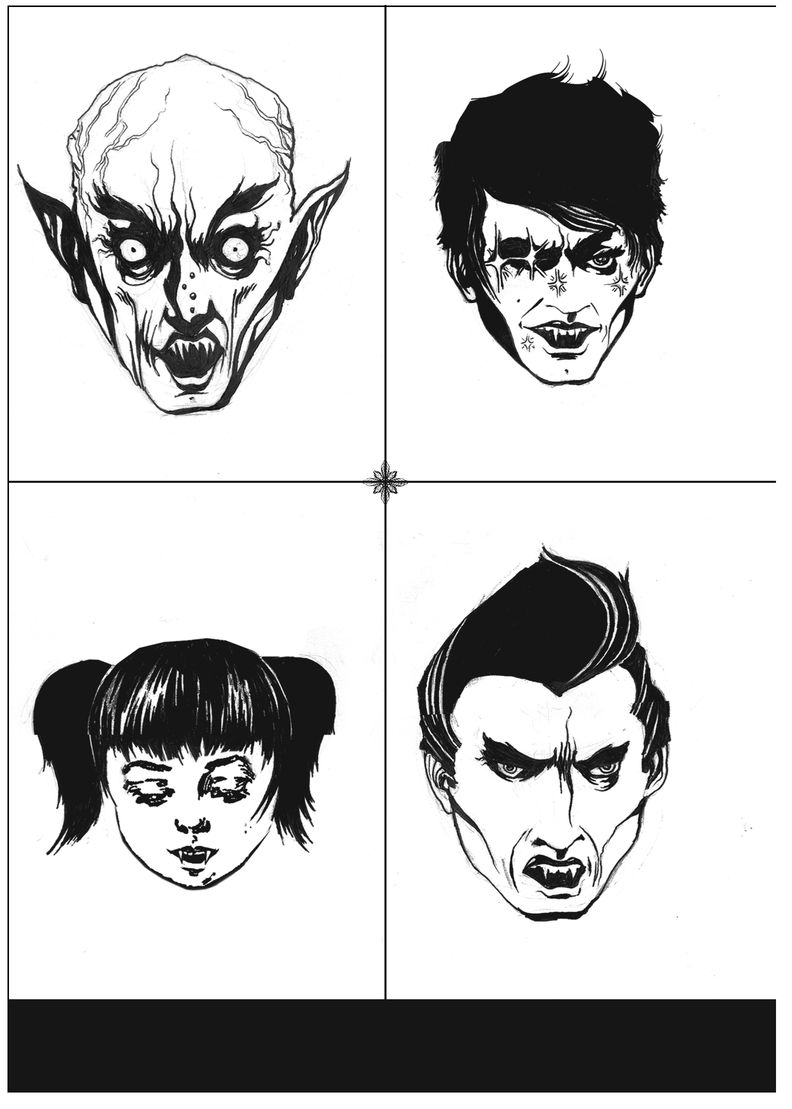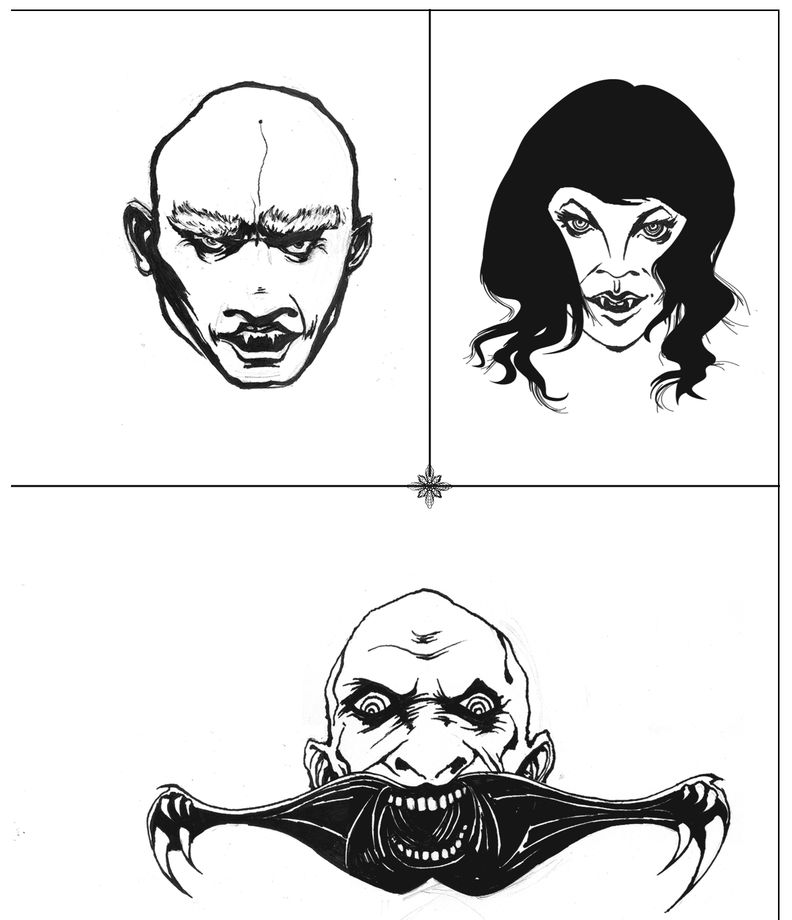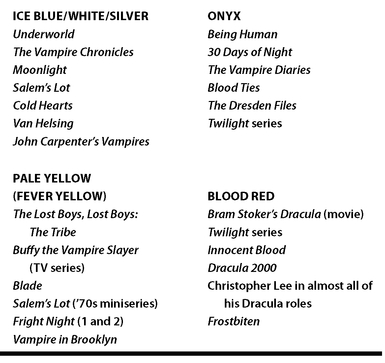Authors: Meredith Woerner
Vampire Taxonomy (2 page)
God, not happy with the change in plans, sent a few angels to fetch her back to Eden. Lilith made a deal with the angels so she could live on her own and in return became the mother of all demons.
Meanwhile Adam and Eve had their children Cain and Abel. As a young man Cain became jealous of his little brother and murdered him in a rage. Cain was then banished from his family’s land and given a telltale “mark”; what exactly the mark constitutes is up for debate. As legend tells it, Cain stumbled into Lilith’s territory, and the two hit it off. Their future children become the vampires we now know today.
Although there is no reference to Lilith in the Bible or the Torah (just in the Jewish Apocrypha texts that have yet to be confirmed and fall outside what the religion believes), Cain’s unholy brood and a possible Lilith figure are referenced in
Beowulf
.
3
Judas IscariotBeowulf
.
3
The other ancient theory popular among vampire creationists is the idea that vampires have all stemmed from the cursed former friend of Jesus, Judas Iscariot, the apostle who betrayed Christ and turned the Son of God over to the Romans. As folklore tells it, Judas, who ransomed Jesus for thirty silver pieces and then later committed suicide, was hexed. He and his entire family were cursed for their betrayal, and also for the suicide (which is considered a mortal sin). It does, however, lend some credence to the idea that silver is a vampire repellent.
4
4

Most vampire enthusiasts are aware that the historical figure Vlad III the Impaler, Prince of Wallachia, was more rumored than plausible as the Father of the vampiric species. The hype surrounding his surname,
Dracula
(Romanian for “son of the dragon”), is due to the success of Bram Stoker’s work and the Dracula franchise. That being said, Vlad is a good example of the vampire heritage legend in which people in the past were punished for their unholy actions by being transformed into vampires. Vlad is infamously known as a brutal ruler and callous torturer. Rumor has it he was never stingy dealing out beheadings, burnings, boil ings, skinnings, and, his favorite, impalings (hence his nickname). Eventually he was made to pay for his evil ways, though Dracula film lore would have you believe his transformation was all for love. It’s easy to see how a historical savage could in legend get linked to an evil immortal being.
Dracula
(Romanian for “son of the dragon”), is due to the success of Bram Stoker’s work and the Dracula franchise. That being said, Vlad is a good example of the vampire heritage legend in which people in the past were punished for their unholy actions by being transformed into vampires. Vlad is infamously known as a brutal ruler and callous torturer. Rumor has it he was never stingy dealing out beheadings, burnings, boil ings, skinnings, and, his favorite, impalings (hence his nickname). Eventually he was made to pay for his evil ways, though Dracula film lore would have you believe his transformation was all for love. It’s easy to see how a historical savage could in legend get linked to an evil immortal being.
Other legends about humans so foul that they’ve turned vampire include rumored torturer and bloodbather Elizabeth Báthory and a small group of French knights from the Crusades. These unholy knights feasted on the flesh of their troops in order to stay alive while stranded in combat. This is where it gets a little blurry: Either the knights were promised immortal life by a demon or changed on their own because of their shameful cannibalism. Either way, they were left as vampires. Some legends have all of the knights (except one sacrifice) leaving the war and starting vampire clans across the globe; others have one knight leaving on his own, soulless, ready to populate the world with vampires.
5
5
THE ORIGINAL TWILIGHT?
In 1887, an Irish author named Bram Stoker published
Dracula
. It wasn’t a bestseller, but wasn’t critically panned—in fact, it received a lot of praise. In 1899, it was published in America. From there it was translated into a play by Hamilton Deane (the man responsible for changing Drac from vile villain to gentleman), and eventually made its way to Broadway in 1927, featuring Béla Lugosi as the title character. The show ended up being Lugosi’s springboard into cinema, where he donned the silken cape and genteel attitude.
Dracula
. It wasn’t a bestseller, but wasn’t critically panned—in fact, it received a lot of praise. In 1899, it was published in America. From there it was translated into a play by Hamilton Deane (the man responsible for changing Drac from vile villain to gentleman), and eventually made its way to Broadway in 1927, featuring Béla Lugosi as the title character. The show ended up being Lugosi’s springboard into cinema, where he donned the silken cape and genteel attitude.
But it was the 1922 German film
Nosferatu
that really got the hype machine started around Dracula. The unauthorized version of Stoker’s
Dracula
was a silent film by Friedrich Wilhelm and starred Max Schreck as the infamous bulbous-headed Count Orlock. (It is also the film that singlehandedly popularized the concept that vampires could be killed with sunlight; even Dracula in the original novel can go out during the day.) The film kicked up a lot of legal dirt. Stoker’s wife attacked the film for copyright infringement, and the case resulted in the ruling that all copies of
Nosferatu
be destroyed. However, prints had already been distributed around the world so it was nearly impossible to track them all down, which is why they exist today.
Nosferatu
that really got the hype machine started around Dracula. The unauthorized version of Stoker’s
Dracula
was a silent film by Friedrich Wilhelm and starred Max Schreck as the infamous bulbous-headed Count Orlock. (It is also the film that singlehandedly popularized the concept that vampires could be killed with sunlight; even Dracula in the original novel can go out during the day.) The film kicked up a lot of legal dirt. Stoker’s wife attacked the film for copyright infringement, and the case resulted in the ruling that all copies of
Nosferatu
be destroyed. However, prints had already been distributed around the world so it was nearly impossible to track them all down, which is why they exist today.
Stoker passed away in 1912, long before he could see the incredible highs that Dracula was destined to achieve all over the world, as well as the incredible number of changes his character would go through. He never lived to see Lugosi’s gentle vampire take or watch Gary Oldman make Dracula a soppy romantic. Nor did he see the franchise grow into cartoons, comics, and cereals. Dracula was the first vampire sensation. And he never even had to sparkle.
Now that you have a general idea of some of the vampire lore, it’s time to learn how to spot ’em. Not all vampires are alike. Depending on the bloodline, different vamps will pick up different kinds of vampire traits. Eyes, appendages, and fangs are all passed on through the sire. This leads to a vast array of vampire characteristics.
LimbsVampires and their limbs usually fall under three different categories: those who sport unpleasant and scaly clawed hands all the time; those who over time have naturally evolved into having human-looking appendages; and those who can shape-shift between the human and beast look.
The immortal hand is a unique evolutionary feature on the vampire. As the public’s attention has increasingly shifted onto vampires over the years, their physical appearance has needed to evolve. No longer can a lower-level vampire get by with deformed mitts similar to those of Max Schreck’s Count Orlok, unless he has his own gang of lackeys to protect and shield him. Clawed hands with three-inch nails tend to bring unwanted attention down upon a vampire’s head. So although you’ll see the mutated talon hand of ancient times now and again, most vampires have evolved beyond the exposed claw.
Vampires brazen enough to flaunt the mangled unholy hand of the devil, so to speak, can usually be classified as Villains (see Chapter 3). Their overall appearance is generally unkempt, cadaverous, and quite frightening, and this extends to their seriously long and lethal fingers and nails. Their fingers appear twice the size of a normal digit, with long fingernails that can grow up to two or even three inches. These talonlike ends are razor sharp and when used with force can open up a neck with the mere wave of a hand. Generally these vampires do not spend a great amount of time interacting with humans—except to eat them—and so don’t see any need to disguise their true form.
Also noteworthy is the power that vampire beasts have over their appendages. An outstretched vampiric arm can move well beyond a normal human’s reach. Villains often use their Stretch Armstrong- like powers to sneak up on an unsuspecting victim. Ever feel a chilly hand on your back even though the closest person in the room is beyond your reach? Chances are it’s the withered claw of a vampire about to caress your artery from behind. But you’ll never catch him; he can move his body faster than your mere mortal eyes see.
6
6
Because some species retain the ability to shape-shift, however, a remarkable number of vampires can transform between their less publicly acceptable appearance and their slightly more human shell easily and quickly. Not looking like a scaly-handed beast really helps with day-to-day dealings and even luring in prey.
7
It is also a great benefit to vampires looking for love in the human world who may otherwise be shunned, particularly because their human appearance is usually quite pleasing. (And it has been reported that those longer-than-human fingers are quite an asset in the romance department.) But get the creature enraged, excited, or hungry and the claws will come out. And in the case of Villainous Vampires (see Chapter 3), they pack a deadly punch.
7
It is also a great benefit to vampires looking for love in the human world who may otherwise be shunned, particularly because their human appearance is usually quite pleasing. (And it has been reported that those longer-than-human fingers are quite an asset in the romance department.) But get the creature enraged, excited, or hungry and the claws will come out. And in the case of Villainous Vampires (see Chapter 3), they pack a deadly punch.


Vampire Craniums
Many of the vamps who don’t transform sport a scaled-back version of the lanky and mutated fist from centuries ago. Modern vamps have appendages that appear delicate but are in reality quite strong, all the way down to the tip of the sharp-as-a-knife fingernail. So be careful even around the fey vampires of late; they can still, most likely, throw you up against the wall, one delicate arm behind their back.
EyesMore diverse than any other part of the vampire anatomy is the nosferatu eye. These blinking beauties come in all shapes and sizes, depending on the vampiric lineage or strain. Usually the maker’s color and anatomy will be passed on to his vampire spawn.
Similar to a litmus test (or a mood ring), the eyes of a vampire can also tell you what the specimen is feeling; for example, if he’s hungry, angry, or tired (all emotions to look out for when dealing with a vampire). The eye color change commonly reflects an increase in adrenaline, be it positive or negative. When you see a vampire eye flash, someone is excited—possibly in a very unhealthy (for you) way. There can also be a dietary-induced color change; the
Twilight
vampires, though they possess many questionable (even among vampires) and unique vampiric traits, have an interesting and sound reason for their optic irregularities.
8
Twilight
vampires, though they possess many questionable (even among vampires) and unique vampiric traits, have an interesting and sound reason for their optic irregularities.
8
COMMON VAMPIRE EYE COLORS

Often optic color changes are paired with a few other facial tics and features. You may see a Cro-Magnon-esque forehead grow to accompany the eye flash, or the mouth may increase in size. The
Buffy
series introduced the world to the not so easy to hide S.V.F., “Sexy Vampire Forehead.”
9
FangsBuffy
series introduced the world to the not so easy to hide S.V.F., “Sexy Vampire Forehead.”
9
Similar to the eye, the vampire species has racked up quite the canine collection over the years. From the mangled overgrown incisors to the actual absence of a pointy-toothed grin, vampires and their fangs have been evolving since the first mention of that sharp smile in
Varney the Vampire: The Feast of Blood
in the 1840s. A great way to chart the evolutionary process of the vampiric race is hanging right from the mouths of the species.
Varney the Vampire: The Feast of Blood
in the 1840s. A great way to chart the evolutionary process of the vampiric race is hanging right from the mouths of the species.
Other books
Chaos Mortalitus by Mark LaMaster
The Wicker Tree by Robin Hardy
Mosquitoes of Summer by Julianna Kozma
The Dead in Their Vaulted Arches by Alan Bradley
Beneath a Hot Tequila Sun by Catelyn Cash
Amber (Jewel Trilogy, Book 3) by Royal, Lauren
Murder in Style by Veronica Heley
The Widow's Son by Thomas Shawver
The Santangelos by Jackie Collins
The Masada Complex by Azrieli, Avraham
